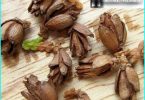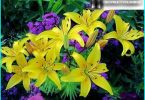The contents
Exotic guest in your cottage
Like most of lush flowering crops, rhododendron is rarely found in the wild in Russia, and grows exclusively under the supervision of gardeners.
Many species survive and feel only in the southern latitudes, so they can be safely grown in the Crimea, the Krasnodar territory or Stavropol territory. However, some varieties, for example, Daurian or Canadian, and are thriving in a temperate climate, so if you live in the suburbs, in the Urals and even in Siberia, rhododendron can also decorate your country site with its magnificent blooms.
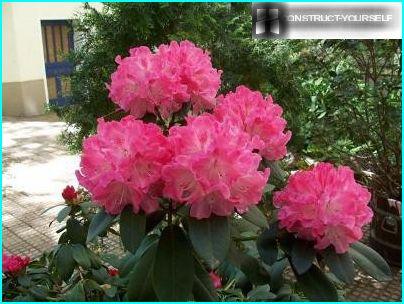
In a literal translation from Latin «rhododendron» means «pink tree» and indeed, its appearance the plant is very reminiscent of the rose, although it refers not to rozotsvetnym, and Heather
One of the species of rhododendron you are definitely familiar – a well-known home Azalea, often decorating the windowsills of city apartments. It is characterized by lush with blooms and variety of colors.
It is impossible to imagine how the relatives of the small plants can reach 25-30 meters in height, although it is actually in the Himalayas, Japan, North America, some species grow to such huge sizes.
There are low and rhododendrons, which is a separate bushes or prostrate shrubs that feel comfortable at the foot of mountains and in coastal areas.
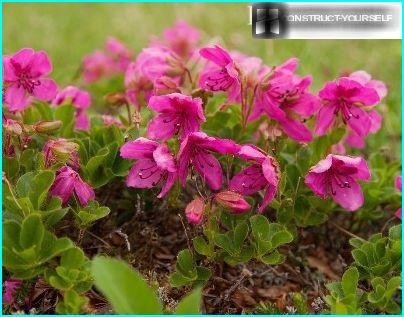
The mountain varieties are usually small in size and are ideal for the organization of the Alpine hills. For example, the Kamchatka rhododendron is unpretentious, grows only up to 35-40 cm in height and has bright pink shade
Among annuals and perennials (and all types of about 3 thousand), you can select grade, which characteristics are suitable for cultivation in a particular region.
If you need a particular hue – red, purple, white or yellow is also not a problem, as color palette of cultures is almost limitless. Flowering of culture starts early spring and continues throughout the warm period.
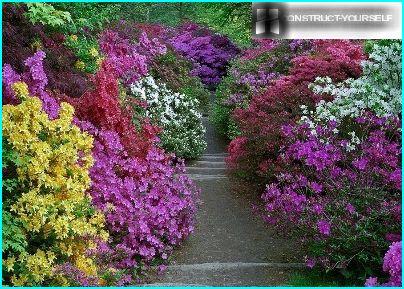
The luxurious color palette of garden azaleas can be combined with different kinds of flowering crops and used for cultivation in the columbarium, the rock garden, tiered flower beds
Planting rhododendrons: time, soil, lighting
Following the General recommendations, planting can be done in the fall and in the spring, that is in a convenient growing period except flowering time and a short period after flowering is about 10 days. However, experienced gardeners still insist on spring planting, which lasts, depending on the region, from April to may 10-15.
Varieties planted before that period, by the may holidays are already covered with a thick color on a background of barely hatched foliage and fresh herbal greens, they look very impressive.
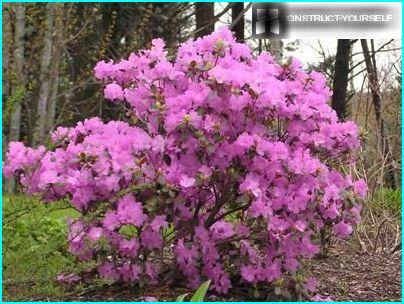
One of the early blooming rhododendron is a variety P. J. Mezitt is a magnificent plant with pink-purple buds. The beginning of its flowering occurs in late April – early may
It is important to choose the landing site, as in bright sun the plant will feel uncomfortable, and in a completely dark place, will not give lush flowering.
A bed of rhododendrons the best break on the North side of the building, palestinina area at noon when the sun’s rays reach maximum power, the plant was closed from them.
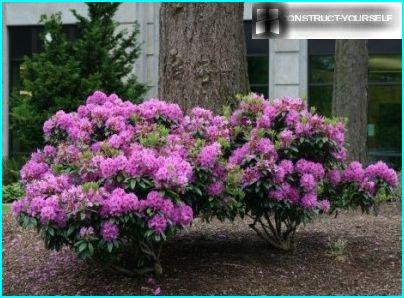
Shadow barrier for the flower garden can serve not only the walls of the building, but a fence or tall trees. The rhododendron gets along well with trees, with roots deep in the soil and interfere with plant development, the oaks, larches, firs, and fruit – pear or Apple
Flowers absolutely do not tolerate alkaline or neutral soil – it must be acidic, humus-rich, well-aerated, free of impurities lime. One of the best materials for growing a mixture of peat and clay.
Rhododendron planted in the following order:
- dig pits, a shallow (35-40 cm) and wide enough (55-60 cm);
- the lower part drained sandy-pebble layer (10-15 cm);
- cover them with a mixture of loam and peat (sphagnum or upland, with low acidity), while peat should be about 2 times more;
- lightly tamp the soil inside the pit and make in it a hole the size of under soil ball seedlings;
- dip the roots of seedling in the hole with more potting mix on the root collar, which needs to be on the same level with the ground surface;
- abundantly water the plant if the soil is dry;
- produce mulch (to a depth of 5-7 cm), where suitable peat moss, decomposed needles, leaves and shredded bark oak.
To better plant acclimatized in the new place before planting thoroughly soak the roots with water – dip the seedlings in a container of water until, until the surface will not cease to cause the air bubbles.
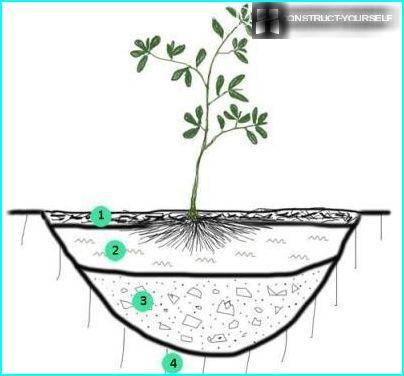
The approximate scheme of planting rhododendron: 1 – garden soil; 2 – drain; 3 – soil mixture of peat, clay or loam; 4 – layer of pine needles.
There is another trick that promotes better development of root system. In a flowering plant, cut the most lush buds – thus the seedling more effort spent on rooting. Planting and further care of rhododendrons – important steps, following which you will achieve amazing results.
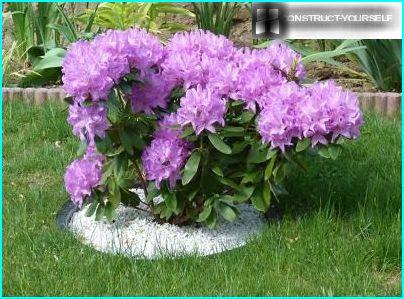
The design of the planted Bush to do better in a few weeks after rooting. You can give a plant a certain shape, and the base to decorate depending on the style of landscape design of your site
The nuances of taking care of flowers
Rules of proper care of flowering shrubs do not differ from the generally accepted standards must be observed irrigation mode, in time produces the weeding and pruning, fertilize the plant with suitable minerals and to make sure that is not infested pests.
There are subtleties, for example, a careful approach when loosening. The roots of the plants are very close to the surface, so loosen the soil to be very careful and dig and not to be. Removing weeds, in any case, do not use a spade or garden knife, you can act manually.
Mode and features irrigation
The ratio of rhododendron to moisture is very interesting. On the one hand, he absolutely does not tolerate waterlogged, on the other – require constant spraying and watering with a specially prepared water.
During selection, planting, check to see if close to the surface of groundwater. The fact is that a large amount of moisture in the soil the roots just «choke» and the plant will die. That’s why you need a drainage layer to drain excess water.
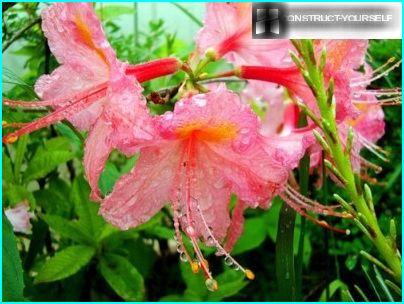
It is especially important to keep the watering and the atmospheric irrigation during the development of buds and flowering – watering the better, the brighter and more luxuriant will be the blossoms
Watering is carried out regularly, pre-acidifying water for 12-20 hours before watering in a container of water, put 2-3 handfuls of sphagnum peat. Water from the tap is better not to use, in an extreme case, it is necessary to defend. Ideal – rain fees. The regularity of watering depends on the state of the plant as soon as the leaves have lost their glossy Shine and changed the turgor – time water.
When is the best time to produce a crop of plants
The concept of cropping is very conditional. Typically the plant develops evenly and forms a floriferous Bush correct form, so fans of lush flower beds, pruning is not necessary. But sometimes you want to thin out the shrub to make it a little lower or just to rejuvenate.
Pruning carried out in early spring, before the SAP flow. Choose strong, thick branches with a diameter of 3-4 cm cut off the ends of the clippers and treat slices specially prepared garden pitch or resin. In about a month will start the updating process, continuing throughout the year will hatch and the new shoots begin to grow the buds.
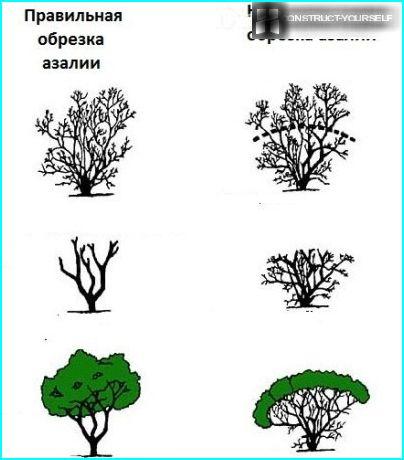
Special skills requires trimming frozen or old bushes: thick branches should be cut at a distance of 35-40 cm from the ground alternately for 2 years: a part of this year, the second in the following
Rhododendrons differ uneven flowering. If this year they brought a particularly riotous color, next, expect a more modest outcome. To avoid this, remove withered buds immediately after flowering, then the plants are strong enough to get around the kidneys and in the second year.
Protection from pests and diseases
Branched shrubs with dense foliage and lots of buds – a great residence for insects, half of which can destroy the beauty you have grown in a couple of weeks, so to protect Bush needs to take a number of measures.
Thick trunks and branches – a favourite place for shellfish. Slugs and snails are harvested by hand. Beware of scale insects, bedbugs, spider mites, rhododendron flies, mealy worms. Stems and branches handle 8% fungicide «Tiramos», helps «Malathion».
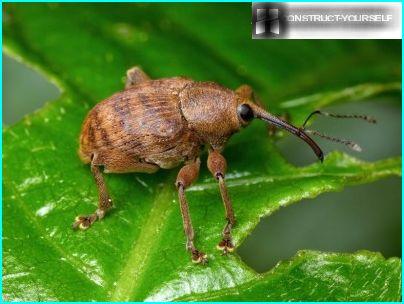
More difficult to bring bedbugs, mites, and especially weevil, to get rid which is used diazonin. Remember, to say goodbye to harmful guest, you have to handle not only the plant itself, but also the top layer of soil around it
Along with the insect pests of rhododendrons threatening diseases of fungal type – rust, chlorosis, mottling. The reason lies in inadequate aeration and failure to comply with the watering. The yellowing that results of the disease chlorosis, treat with a solution of a chelate of iron. If there is rot, the affected shoots should be cut off completely. For the prevention of seasonal processing liquid Bordeaux in late autumn or in early April.
Application and choice of fertilizer
To begin to feed rhododendrons need with planting and throughout flowering period. To preserve important cultural acidic medium is used superphosphate, potassium sulfate, potassium nitrate, magnesium sulfate or calcium, and ammonium, but the minimum concentration.
Early spring fertilizer is composed of fertilizer that contains nitrogen (for 1 cubic meter of liquid 40-50 g of magnesium sulfate or ammonium), it is relevant in the period after flowering. In July, the dose of fertilizers should be reduced to 20 g.
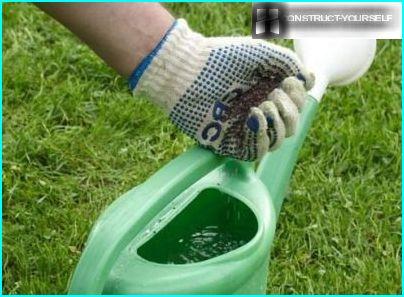
The perfect dressing to rhododendrons – liquid natural fertilizers, such as horn flour or cow dung. Rotted manure is diluted with water (1 part fertilizer to 15 parts water), insist 3-4 days, and used in irrigation
After 1-2 years after planting, you need to update the top layer of soil. For this peat in equal parts mixed with humus or compost and sprinkle the area around the roots. Along with the natural ingredients in the filling add superphosphate, potassium sulfate or ammonium (dry solids – 1 tbsp. spoon). As a dry powder can be used «Agricola» for flowering garden plants. Remember that you only need to fertilize carefully watered bushes.
Methods of reproduction – which one to choose
Take a look at three of the most successful method of propagation of the rhododendron garden conditions:
- seeds;
- cuttings;
- layering.
Growing plants from seed – employment is long and laborious. Dry and healthy seeds are sown in pots or boxes with wet peat, add a little sand to cover the glass domes and put in a well-lit place. During the month, moisten the soil and wipe the condensation from the glass.
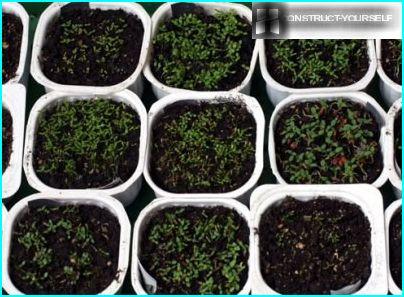
Appeared after 4 weeks the seedlings are planted in a greenhouse with a cool climate under the scheme 2 x 3 cm, the Seedlings will grow for a very long time, and only after 6-7 years you will see the first flowering
Propagation by cuttings is also kept far from all growers. It is necessary to take the shoots, half-stiff, and cut from them a few cuttings with a length of about 7-8 cm.
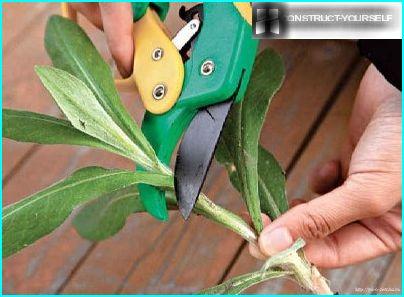
Removed from the bottom of the leaves, and the treated end placed in a container with IAA — a growth stimulator, which stand 12-15 hours
Then placed in peat soil and covered, as in the case of seeds. Depending on the cultivar, the cuttings will root in 2-4 months, after which they are transplanted into boxes with a peat-pine ground and stand in a cool greenhouse. Optimum temperature — 10?C. Planted in the spring along with other colors, right in the boxes, and only a couple of years can be transplanted to the main growing area.
The most convenient way to reproduce the pinning of a nucleus. Take a flexible bottom escape beside him rip groove 12-15 cm deep, and placed the bone in the groove.
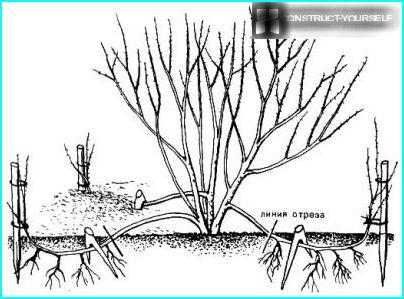
He did not rise, the middle part of the stem bolt and cover with peat. The upper part must output and bind to the support – wooden peg stuck in the ground
Caring for the graft cuttings in the same way as for all the Bush – watered, sprayed. When it takes root (late autumn or spring), it neatly separated, dug and transplanted to the place of permanent growth. This method is especially good for breeding deciduous rhododendrons.
The most popular holiday varieties
In the coniferous garden get along well 2-3 metre Daurian rhododendron. He is distinguished for abundant flowering buds, reaching a diameter of 4 cm.
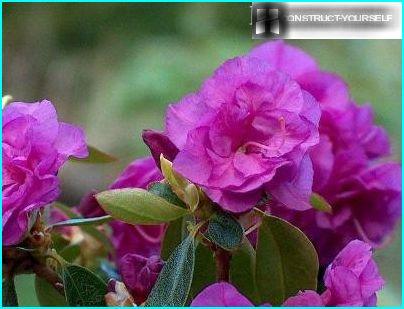
If the warm season is prolonged, the Daurian variety you are sure to please autumn re-flowering, winter-hardy and next spring the plant will bloom in normal mode
Rhododendron Adams – East guest, accustomed to the rocky mountain soil.
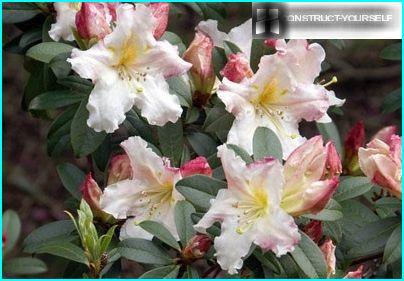
A beautiful plant with pale pink flowers grows up to five feet in height. In our country are uncommon, and in Buryatia registered in the Red book
Low creeping Caucasian rhododendron – a real gem for rock gardens.
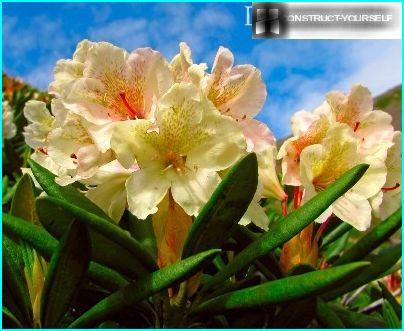
The petals of inflorescences of Caucasian rhododendron have unusual pale yellow or cream shade, which is great diluted with more saturated, bright colors of other varieties
Japanese rhododendron – a superb deciduous variety with buds the color Flamingo.
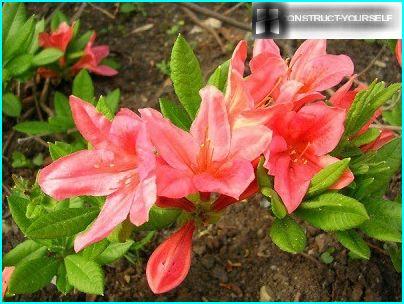
Japanese rhododendrons with exquisite flowers and colourful, blushing in autumn foliage unpretentious, winter hardy and perfectly reproduce in any way – a great option for cultivation in Central Russia
And finally — a short video on how to achieve lush flowering rhododendrons.


